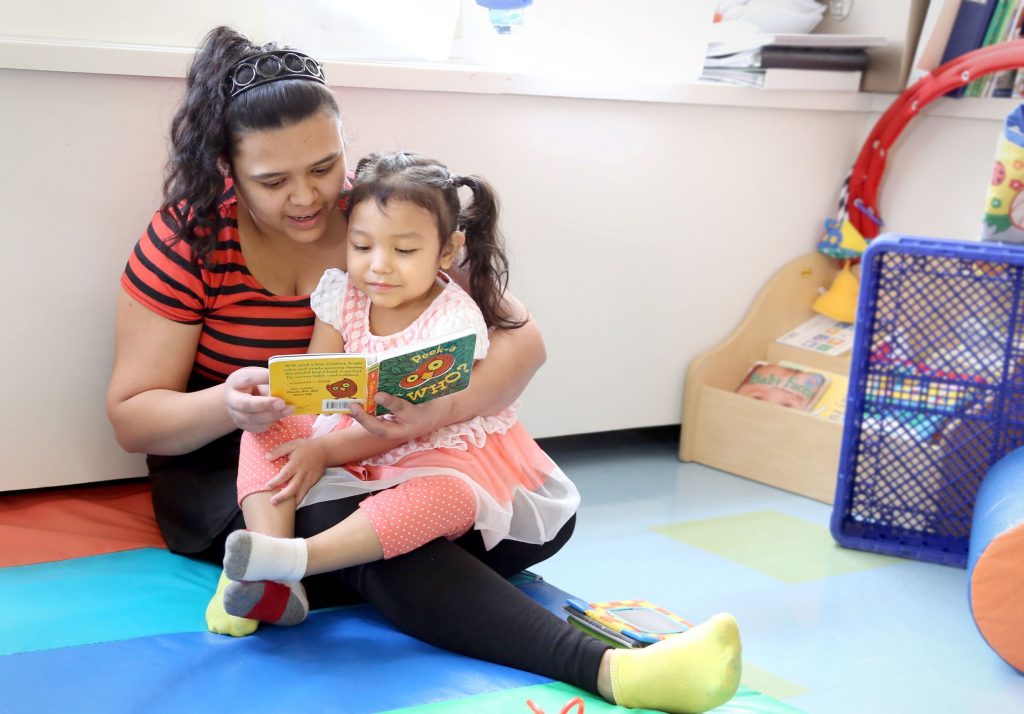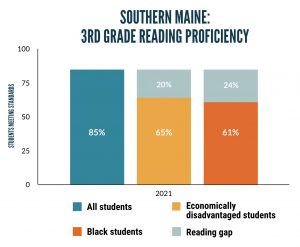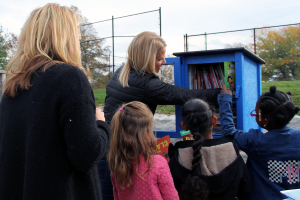
Many things have changed since Thrive2027 first launched, around the world and here in Southern Maine. Some changes are positive, like Thrive2027’s expansion from Cumberland County into all of Southern Maine. Other changes present critical challenges. The COVID-19 pandemic lingers, and we will feel the repercussions for decades. And the economy continues to create challenges for households working towards financial stability.
Our community’s vision, Thrive2027, is to give kids a strong start, empower our neighbors to thrive, not just survive, and help everyone in Southern Maine live longer, better remains more important than ever. Yet, given the evolving needs of our community, we have adapted how we focus our efforts to make the greatest impact and measure our progress.
Since 2017, Thrive2027’s Goal 1 has been that we will give kids a strong start by ensuring that 70% of kids in 3rd grade are reading proficiently. Before 3rd grade, kids learn to read. After 3rd grade, kids read to learn. Reading proficiency at that age is often an indicator of success later in life.
However, data show a wider reading proficiency gap for Black students and economically disadvantaged students. As such, the Thrive2027 Council voted to change the headline indicator for Goal 1 so that, as a community, we can better focus our efforts on closing equity gaps in student learning.
The new headline indicator for Goal 1 is to reduce the reading proficiency gap to no more than 10 percentage points between all third-grade students and students from populations with historical inequities.
Hear Stephanie Nicoson, Senior Community Impact Manager of Education at United Way of Southern Maine, explain the changes to Goal 1.
Data Dive: Reading Proficiency in Southern Maine

As of 2021, 85% of third-grade students in Southern Maine are reading proficiently, according to the Northwest Education Assessments. When we examine the data more closely, we see that students from populations with historical inequities are not meeting benchmarks. The reading proficiency gap between all students and specific groups, including Black students and students from economically disadvantaged households, range between 20-24 percentage points. The Maine Department of Education may change the reading assessment tests from year to year, but this gap remains measurable regardless of the test.
United Way of Southern Maine and other Thrive2027 partners will continue to follow the data to identify other groups experiencing reading proficiency gaps. As a community, we can take action to close those gaps to 10 percentage points or less.
How You Can Take Action:
- Volunteer to read to students in elementary schools. Email Stephanie Nicoson at snicoson@uwsme.org for more information.
- Advocate at the state or local level for policies and funding focused on helping students reach important milestones. Sign up for United Way’s Advocacy Alerts by emailing advocacy@uwsme.org.
- Join Brick & Beam Society, a United Way giving circle focused on supporting STEAM (Science, Technology, Engineering, Arts, and Math) and early learning initiatives in Southern Maine.

Community Spotlight: WEX Advances Youth Literacy
WEX collaborated with United Way of Southern Maine to build and install six Little Free Libraries at East End Community School and Boys & Girls Clubs of Southern Maine Portland Club. Each library is stocked with high-quality children’s books recommended by the school librarian, and WEX employees will run book drives to keep the libraries stocked. WEX employees will also participate in a Volunteer Reader Program at East End Community School through United Way.
If your company is interested in funding Little Free Libraries, reach out to volunteer@uwsme.org for more information.
Closing the Reading Proficiency Gap in Southern Maine
November 18, 2022
Many things have changed since Thrive2027 first launched, around the world and here in Southern Maine. Some changes are positive, like Thrive2027’s expansion from Cumberland County into all of Southern Maine. Other changes present critical challenges. The COVID-19 pandemic lingers, and we will feel the repercussions for decades. And the economy continues to create challenges for households working towards financial stability.
Our community’s vision, Thrive2027, is to give kids a strong start, empower our neighbors to thrive, not just survive, and help everyone in Southern Maine live longer, better remains more important than ever. Yet, given the evolving needs of our community, we have adapted how we focus our efforts to make the greatest impact and measure our progress.
Since 2017, Thrive2027’s Goal 1 has been that we will give kids a strong start by ensuring that 70% of kids in 3rd grade are reading proficiently. Before 3rd grade, kids learn to read. After 3rd grade, kids read to learn. Reading proficiency at that age is often an indicator of success later in life.
However, data show a wider reading proficiency gap for Black students and economically disadvantaged students. As such, the Thrive2027 Council voted to change the headline indicator for Goal 1 so that, as a community, we can better focus our efforts on closing equity gaps in student learning.
The new headline indicator for Goal 1 is to reduce the reading proficiency gap to no more than 10 percentage points between all third-grade students and students from populations with historical inequities.
Hear Stephanie Nicoson, Senior Community Impact Manager of Education at United Way of Southern Maine, explain the changes to Goal 1.
Data Dive: Reading Proficiency in Southern Maine
As of 2021, 85% of third-grade students in Southern Maine are reading proficiently, according to the Northwest Education Assessments. When we examine the data more closely, we see that students from populations with historical inequities are not meeting benchmarks. The reading proficiency gap between all students and specific groups, including Black students and students from economically disadvantaged households, range between 20-24 percentage points. The Maine Department of Education may change the reading assessment tests from year to year, but this gap remains measurable regardless of the test.
United Way of Southern Maine and other Thrive2027 partners will continue to follow the data to identify other groups experiencing reading proficiency gaps. As a community, we can take action to close those gaps to 10 percentage points or less.
How You Can Take Action:
Community Spotlight: WEX Advances Youth Literacy
WEX collaborated with United Way of Southern Maine to build and install six Little Free Libraries at East End Community School and Boys & Girls Clubs of Southern Maine Portland Club. Each library is stocked with high-quality children’s books recommended by the school librarian, and WEX employees will run book drives to keep the libraries stocked. WEX employees will also participate in a Volunteer Reader Program at East End Community School through United Way.
If your company is interested in funding Little Free Libraries, reach out to volunteer@uwsme.org for more information.
Filter by Category